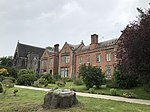Stone railway station
1849 establishments in EnglandDfT Category F2 stationsFormer North Staffordshire Railway stationsGrade II listed railway stationsPages with no open date in Infobox station ... and 7 more
Railway stations in Great Britain closed in 1849Railway stations in Great Britain opened in 1848Railway stations in Great Britain opened in 1849Railway stations in StaffordshireRailway stations served by West Midlands TrainsStone, StaffordshireUse British English from May 2012

Stone railway station serves the market town of Stone, Staffordshire, England. The station is located on a junction of the Colwich to Manchester spur of the West Coast Main Line, but has platforms only on the branch from Stafford to Stoke-on-Trent.
Excerpt from the Wikipedia article Stone railway station (License: CC BY-SA 3.0, Authors, Images).Stone railway station
Station Approach,
Geographical coordinates (GPS) Address Nearby Places Show on map
Geographical coordinates (GPS)
| Latitude | Longitude |
|---|---|
| N 52.908 ° | E -2.155 ° |
Address
Platform 2
Station Approach
ST15 8ES , Stonefield
England, United Kingdom
Open on Google Maps





